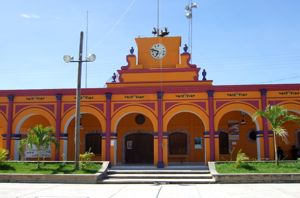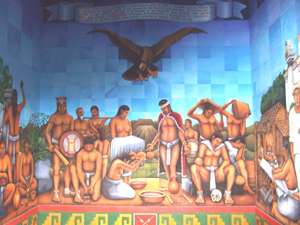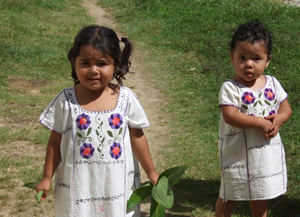TRADITIONAL PRACTICES - USOS Y COSTUMBRES
By Barbara
Schaffer
In
this magazine, we have written much about the peoples of the coast:
their customs, music, food and crafts. But we have missed something
of equal interest, something that cannot be photographed, visited,
experienced or purchased, and yet that has attracted the attention
of the outside world. I speak of the unusual autonomy enjoyed by
each of Oaxaca's 570 municipios (counties).
Although
Mexico, with a federal government and 32 states, plus the DF, is replete
with competing mazes of bureaucracies, the municipality is the basic
form of local governance. Our federal and state taxes end up here,
when it comes to community services. The teachers are paid by the
state and follow a national curriculum, but the municipalities build
the schools. Public works, primary health care, water, markets, police
- these are some of the responsibilities of a municipal government.
The
roots of the municipal system date back to pre-Hispanic Mexico, but
local government was also an integral part of the colonial regime.
The Constitution of 1917 recognizes the importance of the "Free
Municipality" as a territorial division having certain, fundamental,
administrative responsibilities. Mexico has 2,435 municipalities;
more than 1/5 of them are in the state of Oaxaca.
It
can be argued either way as to whether it's a good thing for Oaxaca
(pop. 3.6 million) to have so many small municipalities in a country
where most are quite large. The entire state of Baja California (pop.
2.8 million) only has five. But one thing is certain, and that is
that Oaxacans are closer to their local governments than are most
other Mexicans.

San Pedro Amuzgos
In
1995 the State of Oaxaca took the radical step of allowing each of
its municipalities to decide on its own form of elections. Prior to
that year, the candidates for municipal president, tax collector,
and various commissioners ran as members of a political party, and
the voting, at least in theory, was by secret ballot. The reality
was that the PRI party controlled the great majority of the local
governments. The new law allowed each municipality to decide if it
wanted to choose its officials according to its own traditional practices
(usos y costumbres) or if it wanted to continue with the political
party system.
History
At
least since the 1960s, indigenous rights groups had been demanding
political autonomy for native communities throughout Mexico. The new
law satisfied many of these demands by giving legal recognition to
already established practices. But it wasn't just to protect indigenous
rights that two successive PRI governors - Heladio Ramírez
López (1986-1992) and Diodoro Carrasco Altamiro (1992-1998)
- pushed the legislation through. Since 1980 the PRI had been losing
deputies in state elections, and supporting direct democracy was seen
as a way of staunching the flow. It was better not to have any official
PRI connection with the municipal governments than to have the PRD
or PAN win another local election.
Most
of the 418 municipalities which chose usos y costumbres had been PRI
strongholds. The 152 which went for keeping the party system tended
to have a history of multiparty elections. Locally, San Pedro Mixtepec
voted for party elections, and Santa María Colotepec opted
for usos y costumbres.
Traditional
Practices
The
basic model (with many possible variations) starts with the selection
of candidates by the municipality's Council of Elders. The Elders,
almost always men, have attained to this office by having, over the
years, donated their time and money to a prescribed number of functions
ranging from serving as constable to sponsoring the yearly feast of
the patron saint. (Not so long ago, the first step on the ladder was
being the town messenger, which included running from village to village.)

Palacio municipal, Jamiltepec
The
Elders present their list to the municipal assembly which then debates
on the merits of the candidates and has the final vote. It is up to
each municipality, to decide, according to its traditions, who is
included in the communal general assembly. In most communities all
adults born in the municipality have the right to participate in the
assembly, but that is far from being the universal experience.
In
some municipalities, only people living in the county seat (cabecera)
can vote, in others non-Catholics are excluded, and 80 of the 418
municipalities (almost 20%) do not allow women to vote in municipal
elections. (In some others women do not participate without their
being a formal prohibition.)
Although
it may shock our liberal, one person-one vote sensibilities, the system
of usos y costumbres is not meant as a step away from democracy but
rather as a recognition of the right of indigenous people to follow
their own traditional political practices. Thus where consensus is
seen as higher virtue than simply getting the most votes, voting is
done by voice, by standing behind a candidate, or by drawing a line
on a black board.

San Pedro Amuzgos
Does
the system work? Not always, judging by the relatively high number
of contested elections that have to be referred to the state for mediation.
But few, if any, of the municipalities which chose usos y costumbres
in 1995 have voted to return to the former system of party politics.
Santa
María Colotepec
As
may be expected, local traditions have changed enormously in recent
years in Colotepec, a municipality of over 13,000 inhabitants, many
living in Puerto Escondido. Here the general assembly includes every
resident with a federal voting card, even naturalized citizens, and
anyone who wants to may run for office. Since around 2000, the assembly
has voted by secret ballot. In this case, usos y costumbres means
that voters must go to the county seat of Colotepec for the meeting
of the general assembly to cast a ballot, and candidates cannot run
under the auspices of a political party.

